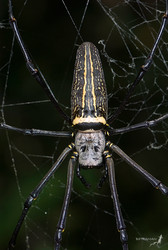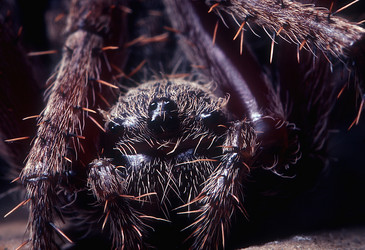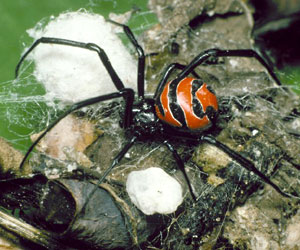Orbiculariae
Jonathan Coddington


This tree diagram shows the relationships between several groups of organisms.
The root of the current tree connects the organisms featured in this tree to their containing group and the rest of the Tree of Life. The basal branching point in the tree represents the ancestor of the other groups in the tree. This ancestor diversified over time into several descendent subgroups, which are represented as internal nodes and terminal taxa to the right.

You can click on the root to travel down the Tree of Life all the way to the root of all Life, and you can click on the names of descendent subgroups to travel up the Tree of Life all the way to individual species.
For more information on ToL tree formatting, please see Interpreting the Tree or Classification. To learn more about phylogenetic trees, please visit our Phylogenetic Biology pages.
close boxTree based on Griswold et al. 1998, modified after Lopardo and Hormiga 2008.
References
Agnarsson, I. 2004. Morphological phylogeny of cobweb spiders and their relatives (Araneae, Araneoidea, Theridiidae). Zoological Journal of the Linnean Society 141:447-626.
Coddington, J.A. 2005. Phylogeny and Classification of Spiders. In D. Ubick, P. Paquin, P. E. Cushing, and V. Roth (eds.) Spiders of North America: an identification manual, American Arachnological Society. 377 pages. Chapter 2, pp. 18-24.
Coddington, J. A. and H. W. Levi. 1991. Systematics and evolution of spiders (Araneae). Annual Review of Ecology and Systematics 22:565-592.
Forster, R.R., N.I. Platnick & J. Coddington. 1990. A proposal and review of the spider family Synotaxidae (Araneae, Araneoidea), with notes on theridiid interrelationships. Bulletin Of The American Museum Of Natural History 1-116.
Griswold, C.E. 2001. A monograph of the living world genera and Afrotropical species of cyatholipid spiders (Araneae, Orbiculariae, Araneoidea, Cyatholipidae). Mem. Calif. Acad. Sci. 26:1-251.
Griswold, C. E., J. A. Coddington, G. Hormiga, and N. Scharff. 1998. Phylogeny of the orb-web building spiders (Araneae, Orbiculariae: Deinopoidea, Araneoidea). Zoological Journal of the Linnean Society 123:1-99.
Foelix, R.F. 1996. Biology of Spiders. Oxford Univ. Press, Oxford. 330pp.
Jocqué, R. & A.S. Dippenaar-Schoeman. 2006. Spider Families of the World. Musée Royal de l'Afrique Centrale, Tevuren. 336pp.
Hormiga, G., N. Scharff, and J. A. Coddington. 2000. The phylogenetic basis of sexual size dimorphism in orb-weaving spiders (Araneae, Orbiculariae). Systematic Biology 49:435-462.
Kuntner, M., 2005. A revision of Herennia (Araneae, Nephilidae, Nephilinae), the Australasian ‘coin spiders’. Invert. Syst. 19, 391–436.
Kuntner, M., 2006. Nephilidae.com: A web resource for nephilid spiders (Araneae, Araneoidea, Nephilidae), version 1.0. http://www.nephilidae.com/.
Lopardo, L. and G. Hormiga. 2008. Phylogenetic placement of the Tasmanian spider Acrobleps hygrophilus (Araneae, Anapidae) with comments on the evolution of the capture web in Araneoidea. Cladistics 24(1):1-33. doi:10.1111/j.1096-0031.2007.00173.x
Opell, B.D. 1979. Revision of the genera and tropical American species of the spider family Uloboridae. Bull. Mus. Comp. Zool. 148:443-549.
Platnick, N.I. 2006. The World Spider Catalog, Version 7.0. http://research.amnh.org/entomology/spiders/catalog/INTRO1.html.
Scharff, N. and J. A. Coddington. 1997. A phylogenetic analysis of the orb-weaving spider family Araneidae (Arachnida, Araneae). Zoological Journal of the Linnean Society 120:355-434.
Schütt, K. 2003. Phylogeny of Symphytognathidae s.l. (Araneae, Araneoidea). Zoologica Scripta 32(2):129-151.
Ubick, D., P. Paquin, P.E. Cushing & V.D. Roth. 2005. Spiders of North America: an identification manual. American Arachnological Society, 377pp.
Title Illustrations

| Scientific Name | Nephila maculata |
|---|---|
| Location | Taiwan |
| Specimen Condition | Live Specimen |
| Sex | Female |
| Source | 070729 台東 綠島 人面蜘蛛 (雌蟲) Nephila maculata (Fabricius) (Female) |
| Source Collection | Flickr |
| Image Use |
 This media file is licensed under the Creative Commons Attribution-NonCommercial-ShareAlike License - Version 2.0. This media file is licensed under the Creative Commons Attribution-NonCommercial-ShareAlike License - Version 2.0.
|
| Copyright | © 2007 Shipher (士緯) Wu (吳) |
| Scientific Name | Araneus bicentenarius |
|---|---|
| Location | USA |
| Specimen Condition | Live Specimen |
| Identified By | Jonathan Coddington |
| Sex | Female |
| Life Cycle Stage | adult |
| Body Part | face |
| View | anterior view |
| Size | photo ca. 5mm across. |
| Image Use |
 This media file is licensed under the Creative Commons Attribution-NonCommercial License - Version 3.0. This media file is licensed under the Creative Commons Attribution-NonCommercial License - Version 3.0.
|
| Copyright |
© Jonathan Coddington

|
| Scientific Name | Latrodectus curacaviensis |
|---|---|
| Location | Bahia (Brazil) |
| Comments | South American widow spider |
| Specimen Condition | Live Specimen |
| Source Collection | CalPhotos |
| Copyright | © 1994 |
About This Page
Jonathan Coddington

Smithsonian Institution, Washington, D. C., USA
Page copyright © 2006 Jonathan Coddington
All Rights Reserved.
- Content changed 23 January 2009
Citing this page:
Coddington, Jonathan. 2009. Orbiculariae. Version 23 January 2009 (temporary). http://tolweb.org/Orbiculariae/2698/2009.01.23 in The Tree of Life Web Project, http://tolweb.org/











 Go to quick links
Go to quick search
Go to navigation for this section of the ToL site
Go to detailed links for the ToL site
Go to quick links
Go to quick search
Go to navigation for this section of the ToL site
Go to detailed links for the ToL site